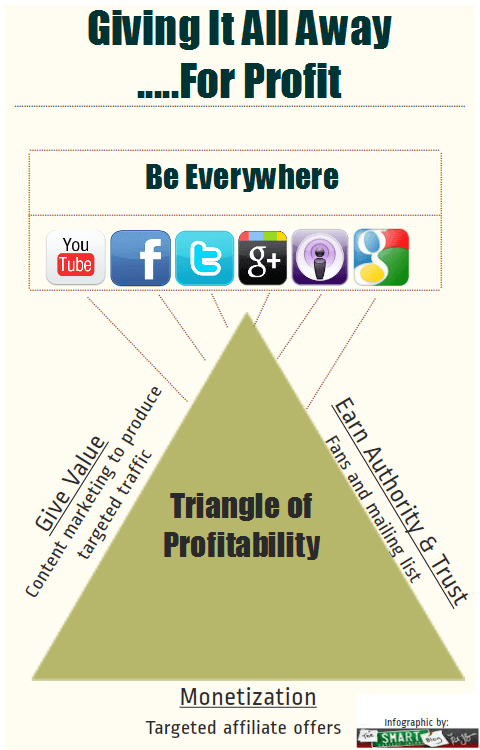This is a guest post by my good friend and mentor, Todd Tressider of FinancialMentor.com. Todd and I are in a mastermind group together (the same one as Jaime Tardy, who recently wrote a guest post about masterminds and mentors on SPI a couple of weeks ago), and he’s also coaching me on the side about investments. Besides being ridiculously tall and a super nice guy (I met Todd in person at the Financial Blogger’s Conference in Chicago last year), he’s incredibly smart when it comes to money. He’s been experimenting with a lot of cool things online for his brand, and he wrote this in-depth guest post to share some findings with you when it comes to giving stuff away and strategies to monetize. Enjoy!
Pat makes it look so darn easy that it can be frustrating.
He gives away his best stuff, and his income skyrockets. I give away my best stuff and, well, I give away my best stuff.
Maybe you can relate? Your results pale in comparison to Pat’s. You only see a trickle of income for your efforts, while his income skyrockets.
Did you ever wonder if you were missing a piece of the puzzle?
In this article, I’ll dive deep into Pat’s “giving it all away” model so that you can learn a few advanced tricks and tips for applying it profitably in your business.
The Hidden Triangle Behind Giving It All Away
Pat’s model looks simple on the surface.
Develop niche expertise and give it all away to your followers through high quality posts, podcasts, and videos. The premise is that great content eventually draws targeted traffic. You then monetize throngs of hungry visitors with the best tools available to satisfy their unmet needs. They joyfully buy from your site because they know, like and trust you to direct them to the best resources.

It’s a simple formula where the triangle of profitability appears to be formed by three sides. Let’s use SPI as an example:
- Pat is a content marketing machine applying the “Be Everywhere” philosophy to the internet marketing niche.
- Targeted readers are attracted to Pat’s site by his useful, high quality content thus building authority and trust.
- Pat offers affiliate products that match the needs of his readers thus he converts without pitching. They just click on the links naturally connected to the useful tutorials and resources he provides.
For example, if you want to make money on the internet you’ll need someone to host your WordPress site and run your email marketing. Bluehost and Aweber are industry leaders that anyone starting out would be well served to use. Pat produces content showing you how to set up a blog in minutes on Bluehost or build an autoresponder system using Aweber. These products are a natural fit and Pat makes a killing offering them. No sales pitch required. They trust Pat’s expertise, he tells them the preferred vendor, they need the service, and conversion results. End of discussion… or is it?
Editor’s Note: We now recommend ConvertKit for your email service provider, rather than Aweber.
What happens if your niche doesn’t offer high quality affiliate programs?
Is there a deeper level of understanding to what Pat is doing? Are there other ways to apply this triangle of profitability to your own business in ways that aren’t obvious based on what you see at SPI?
How To Monetize Your Site Without Affiliate Programs
For example, I’m a financial coach who teaches wealth building strategies. The affiliate programs in my niche are the garbage I educate people to avoid. I can’t offer credit cards, payday loans, and forex trading because it’s out of integrity with my teachings. So how do I monetize?
The obvious answer is to develop my own products and services but that introduces a new problem. You can’t give it all away when the product or service is your own. The triangle doesn’t exist when there is no third side.
In other words, one of the many keys to Pat’s effectiveness is how he monetizes through independent third party products and services. We know there are multiple hosting companies and email service providers with affiliate programs, and we trust Pat to pick the best. He isn’t selling “Pat’s Web Hosting” because then he would be biased. He is telling you about the well-known, trusted name brand that he prefers above all others. We trust he did his homework.
The key point is the sale must occur as a result of something else. The pitch cannot be direct. This is critically important to the system working. In fact, it’s the key to taking the strategy a cut deeper and applying it at every level of your business.
Think about it. We trust Pat because he is truly giving us his best stuff which establishes his expertise through content marketing. We all need the products he offers and fully expect that he has handpicked the best from what is available. We are leveraging his depth of knowledge in the industry by buying what he thinks is best, and he is leveraging our wallets. Both sides win.
This is all fine and good if you can mimic his model, but as I already stated, I can’t do that. There are no affiliate programs for persistence, financial intelligence, and a strategic wealth plan. In fact, very few market niches have the depth of quality affiliate programs that Pat’s niche provides, and that’s a key problem for many of us.
Well, necessity is the mother of invention, so I dug a little deeper into what makes Pat’s model work. I redefined the triangle of profitability so you can figure out how to apply Pat’s model to all those situations in your business where the superficially obvious solution doesn’t fit. Let’s explore this a bit…
How To Give It All Away by Giving Something Else
The key to gaining a deeper perspective on Pat’s model is to redefine the sides of the triangle.
For example, if you redefine the content marketing leg to “giving something of value” many possibilities open up. You can give away personal attention through email responses, a teleseminar or group coaching program, an ebook, a networked resource, a guest post, and much more. The key is you must give something of value that builds trust and authority.
You can redefine the second leg of the triangle from “reader” to “anyone”. In other words, you can give to every human connection you have. It could be the network of bloggers in your niche, it could be your friends and family, or it could be someone else’s list. In fact, it could be all the above. And yes, it can also include your email list of readers. Just don’t limit your thinking to your own list. The concept is much bigger than that.
Finally, redefine “affiliate program” to include any third party monetization strategy. This is critical to shifting your thinking when your niche lacks quality affiliate programs. It could be as simple as an advertising network or it could be two layers removed from your business like Amazon’s targeted client base or Google’s search traffic.
These redefinitions are more than just semantics because they open up possibilities. These broader definitions allow you to create a virtuous triangle of profitability in situations that extend beyond what is superficially obvious from Pat’s affiliate business model. There is far greater depth and potential to what he is doing.
Let’s look at some examples…
Giving Away Amazon Ebooks
Amazon is a massive marketing machine holding the dominant position in the book market. Think about it. If you are looking for a book you don’t Google it. You go to Amazon to search for it similar to how you would search for a video on YouTube or a podcast on iTunes. Just as YouTube owns the video market and Apple owns podcasting, Amazon owns the online book market.
In addition, Amazon provides us with an example of a third leg in Pat’s giving it all away strategy – an independent third party monetization platform – but it operates on two levels simultaneously. The superficially obvious level is their affiliate program where you drive traffic to Amazon and get paid on purchases. That’s one monetization approach we all know.
What a lot of people don’t understand is the incredible power of Amazon’s internal marketing machine. The key to monetizing long term on Amazon is you must provide a great book (sells well, receives great reviews, low return rates) and drive that book up the ranks until Amazon takes notice and begins marketing it for you. That is when it becomes smart passive income.
You’ve probably seen how the Amazon marketing machine works through their direct emails, the “customers who viewed this item also bought this” recommendations, and so on. Amazon has multiple ways of direct selling and cross promoting built right into the largest third party book marketing platform in existence. You just have to figure out how to rise up and get your product noticed on that platform thus leveraging Amazon’s marketing prowess producing sales and passive income beyond anything you could have done on your own.
But how do you achieve that goal? By giving it all away, of course!
As a neophyte, I tried just giving my book away. That’s the duhh-obvious idea. Rather than content marketing I gave the book itself as the item of value (again, we are redefining each leg of the triangle). Unfortunately, this is a problematic strategy when the “something of value” you give away is the very product you want to sell.
The new world of book marketing says the concept works like this: the market for my book inside Amazon is huge so when I give the book to my 7,000 (and growing) loving readers they will “like” the sales page and leave favorable reviews. I give them extraordinary value in the form of a quality book and they help drive the book up the ranking scale with their downloads, likes, and reviews. Amazon’s massive built in market takes notice of the social proof and reader interest thus lifting it up their internal ranking system. The premise is Amazon’s market is far bigger than mine so it is smart business to give the book to my market in an effort to get noticed by Amazon’s market.
The result? It worked okay.
In exchange for giving the book to my best buyers thus pillaging future sales from my list I got 29 likes, 19 great reviews, and bounced around the best seller ranking between 10,000 and 30,000 in the weeks that followed. Better than nothing, but not exactly retirement. It definitely gave the book a kick start selling hundreds of copies and got things moving, but there are smarter ways to apply the principles.
In hindsight, my big mistake was not having the paperback version of the book available for purchase during the promotion. The ebook giveaway would have driven paperback sales creating immediate revenue and greater total sales volume by allowing people to consume in their preferred format. All was not lost, however, as all other books in the same series experienced significant spillover sales from the giveaway.
My next lesson occurred when I gave away a promotional webinar demonstrating how to actually implement a critical aspect of the book’s teaching. The premise was to give “next step” education for people who had already bought and read the book. The only thing I asked was to prove you read the book first by leaving a review showing yourself as a verified purchaser (social proof in Amazon’s system). I didn’t want just anyone in the class – only people who had read the book. This encouraged both purchases and reviews.
Again, the key here is to give killer value to people (in this case, my readers) through value added content (advanced education webinar) and to monetize through a third party platform (Amazon’s massive marketing machine). However, this time I added a twist by requesting an action that cost the reader nothing (a book review showing them as a verified purchaser that can be completed in two minutes). Some might argue that I didn’t give it all away, but I did because I gave the book earlier to my list and invited anyone who wanted the next level of instruction to simply leave a review showing they read the book. The cost was nothing.
The results were surprising.
Many readers left reviews, but they were low quality. The book was 4.95 stars (19 reviews before the promotion) but dropped to as low as 4.7 stars (after 25 additional reviews during the promotion). What I discovered was these readers were leaving genuine reviews but they weren’t familiar with the review process. They didn’t understand how a 4 star review was lukewarm and a 3 star review was actually “critical” in the Amazon system. They incorrectly believed they were leaving positive reviews when they were actually lowering the average rating of the book. Once I pulled the promotion the reviews immediately returned to consistent 5 stars and delivered much higher quality statements about the value of the book.
In summary, these two “give it all away” examples provide a successful case study in creating passive income through Amazon. The book appears (as of this writing) on page 1 in Amazon for the competitive term “retirement planning” in both the “Kindle store” and “books” categories. I still have more work ahead of me, and I’m sure many readers will share great strategies in the comments below to build on what I’ve shared here, but for now I want to point out one more strategy I’m implementing that astute readers might have already noticed…
This Guest Post Is Meta
This guest post is walking the talk. I’m giving you (Pat’s readers) this valuable case study as a gift.
You are Pat’s fans and I’m demonstrating my expanded definition of “readers”. In addition, I’m demonstrating my expanded definition of “affiliate program” to include any third or fourth party monetization strategy.
For example, if you look over this post I don’t have an affiliate link in it. I have no overt monetization that would cheapen this gift or break your trust. However, notice the anchor text links going into the sales page at Amazon and resource pages on my site from Pat’s valuable PR5 site.
It won’t take too many backlinks like this to drive the rankings for the book’s sales page to the top of Google for relevant terms because Amazon is such a highly trusted site. This will cause thousands of targeted searches per month to find my book as an authoritative solution to their question, “How Much Money Do I Need To Retire?” (on page 2 for this competitive term and rising). The sales driven by Google search (independent third party) will, in turn, further boost my rankings within Amazon’s marketing system which will drive additional promotion to their customers (independent third party).
Notice how the monetization is twice removed and never overt. Sure, a handful of you might buy the book, but that is not the intention (although I really appreciate it – oh, and make sure you “like” the sales page while you are there. Thanks!). The real goal is to drive thousands of targeted buyers through my Amazon sales page every month from Google organic search by giving value to Pat’s readers and receiving backlinks as a natural part of that process.
Notice how this strategy is totally different from Pat’s affiliate marketing model even though it is still the triangle of giving it all away. Rather than sell from my site I’m getting two huge marketing juggernauts – Google and Amazon – to do the heavy lifting for me and these two marketing juggernauts are taking their cues to market for me from independent, third party resources (Smart Passive Income).
In other words, this guest post is a meta example of giving it all away; yet, it is totally different from how Pat walks the talk. Pat would never publish this post unless I was giving something hugely valuable to you (creative insights to apply his strategies). In turn, I’m not using an affiliate program and I’m not even giving to my own readers. It is a creative twist on the same principles to fit my own business model.
Taking “Giving it All Away” A Cut Deeper>
The point here is to look more deeply at what Pat is doing here at SPI. His results aren’t random, but they also aren’t easily duplicated by you and me. You’ll need to get creative and find your own twist to make it work.
I had to look behind the superficially obvious to redefine the key principles from SPI into something I could apply in my own business. It wasn’t until I took the learning a cut deeper that I was able to produce meaningful results.
Always remember, when you give it all away you build trust and authority, but without a monetization plan you don’t have a business. That is key!
Everyone wants free ice cream so giving valuable content is the easy part. Figuring out the third party monetization is the critical component too many people miss. I know I did. For SPI the monetization was easy because of the niche. For the financial education niche I had to find more creative solutions.
So now it is your turn. Take these lessons and share in the comments below how you could apply the principles to your own business. Or maybe you thought of more strategies for developing the book business at Amazon that will expand on the ideas shared here. I’m all ears and look forward to a great brainstorming session in the comments below…
Thanks to Todd once again, and don’t forget to visit his website at FinancialMentor.com if you’re interested in learning more about what he does.
And if you want to learn more about affiliate marketing and get started, check out Affiliate Marketing – The Ultimate Step by Step Guide. Cheers!
 Todd Tressider
Todd Tressider
 Daniel Scocco
Daniel Scocco Gregory Ciotti
Gregory Ciotti Sarah Peterson
Sarah Peterson

